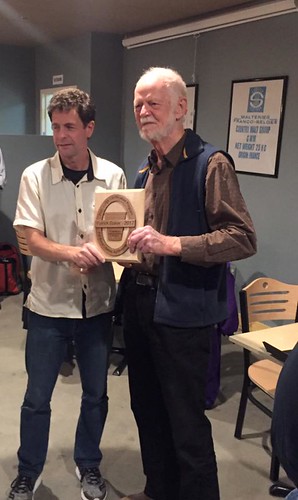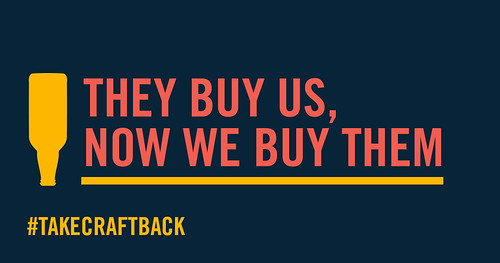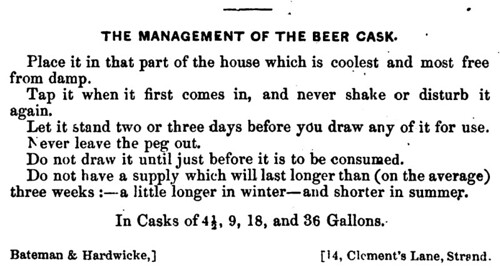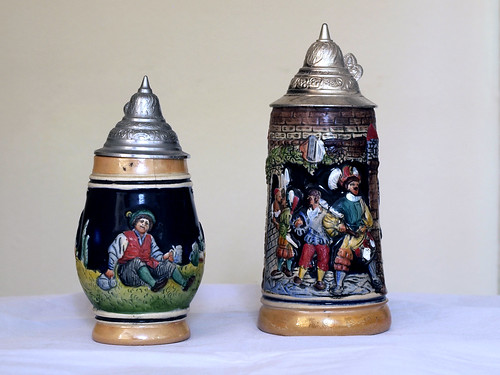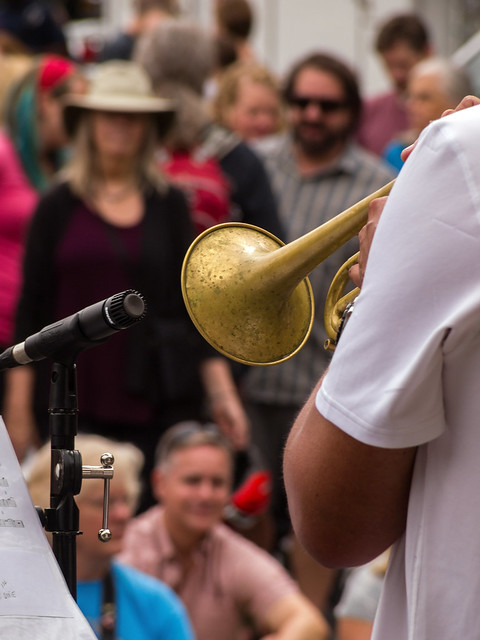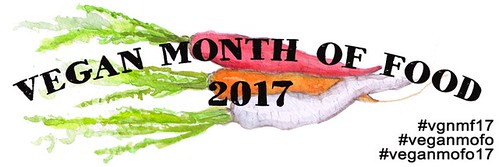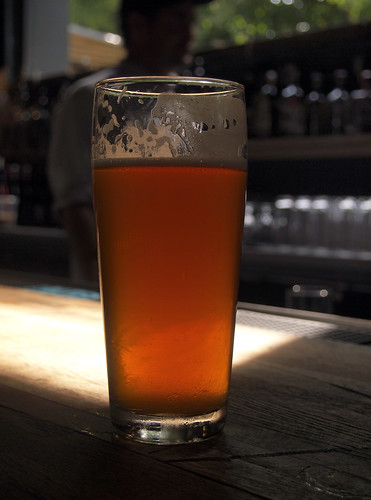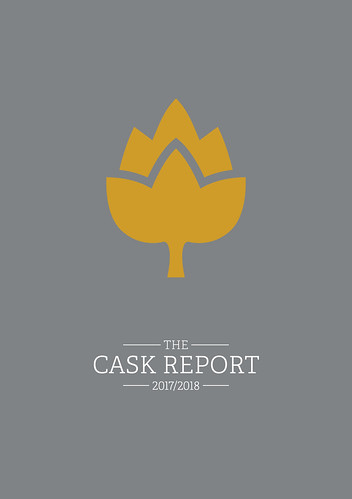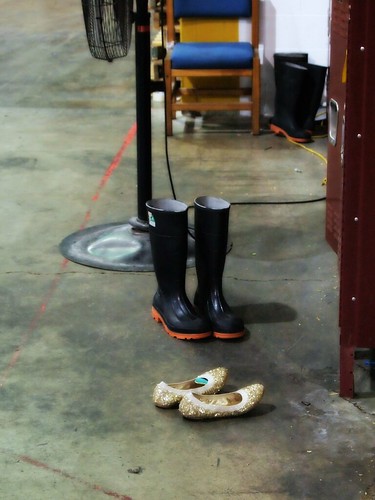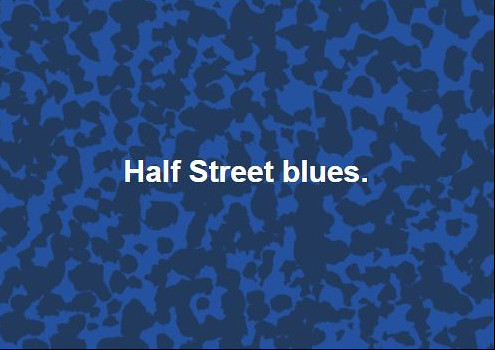
A bi-weekly, non-comprehensive roundup
of news of beer and other things.
Weeks 41/42
8 October - 21 October 2017
- 21 October 2017
In 1985, Pat Baker (on right in photo) founded the Beer Judge Certification Program (BJCP), "a worldwide certifying organization for judges of beer and related fermented products." On 21 October 2017, the BJCP presented him with its first-ever lifetime achievement award, christening it the Pat Baker Lifetime Achievement Award.- Photo courtesy Scott Bickham, BJCP Northeast Regional Representative (on left in photo), on Facebook.
- Additional information via YFGF, on Facebook.
A useful table of beer volume measures.
—Via Beer Culture with Des de Moor.
When the restaurant reviewer for the Washington Post ranked the top 10 restaurants in the Washington, D.C. metro area, a local beer website ranked those restaurants according to their beer lists. Media in other cities should emulate this.
—Via DC Beer .
Fifty-one senators —a bi-partisan majority of the U.S. Senate (out of 100 members)— have co-sponsored Senate Bill 236. Known as the Craft Beverage Modernization and Tax Reform Act (CBMTRA), the bill would cut the federal excise tax for domestic breweries making fewer than two million barrels annually to $3.50 per barrel (currently $7) on their first 60,000 barrels and would reduce and streamline reporting requirements. A similar bill in the U.S. House of Representatives —H.R. 747— also has majority bi-partisan support from 281 members (out of 435). Infighting among members of the U.S. brewing industry —small and independent (so-called 'craft') breweries vs. large breweries— could, however, hurt chances of passage.
—Via Brewbound.
A small 'craft' brewery in Gainesville, Florida, offered to exchange one free draft beer for admission tickets to a speech by white supremacist Richard Spencer at the nearby University of Florida.
We believe free speech is a cornerstone of our great nation. That said, speech that condones, let alone, promotes racial supremacy has no home in America, and it sure as hell doesn't have a home here in our beautiful town. [...] For every two tickets you bring in, we'll trade you for a free Alligator Brewing draft beer. Those tickets and reserved spots will be disposed of, leaving two more empty seats in the Philips Center. We, unfortunately, can't stop [Richard Spencer] from bringing his hate to Gainesville, but we can empty the room so his disgusting message goes unheard.—Via Esquire.
The (beery) etymology of the word "nip": "the smallest imaginable measure of beer."
In his 1785 Classical Dictionary of the Vulgar Tongue, Francis Grose doesn’t list 'nip' but does have this rather wonderful related entry: 'Nipperkin, a small measure.' By the time a new edition came out in 1788, nip had been added: 'Nyp, or Nip. A half pint, a nyp of ale: whence the nip-prekin, a small vessel.' [...] When the Weights & Measures Act of 1824 was passed it did not include the 'nip/nipperkin' among the new standard Imperial units of volume which meant that, legally speaking at least, it ceased to exist.—Via Boak and Bailey.
The [U.S.] Brewers Association (BA) —the not-for-profit organization that “represents America’s small and independent brewers”— has proposed, supposedly tongue-in-cheek, a crowd-sourced campaign to #TakeCraftBack from Anheuser-Busch InBev — the international beer behemoth that has been busy acquiring small breweries across the country and the world— by purchasing the conglomerate for $213 billion, its current value. To reach that goal, every American would have to contribute $655 dollars apiece. As of 16 October, $1,591,390 had been 'pledged.' Although the BA says it doesn’t intend to collect from donors, it does promise swag for each. “We have no doubt that your pledge, and all the others like it, has Big Beer quaking in their [sic] custom-made Italian loafers.” It appears that this campaign is a followup to the Certified Independent Craft Beer Seal that the BA launched in June 2017.
—Via [U.S.] Brewers Association, at TakeBackCraft.
"Love beer hate, pubs?" British beer writer Des de Moor on the (not-always-salubrious) past of British pubs and their evolving present (and future).
The idealised view of the inclusive community pub of the past, where everyone was welcome, is not only contradicted by the facts of physical segregation in pubs at least up until World War II, but by the lived experience of anyone who found themselves outside the prescribed normality of the communities that used them.—Via Beer Culture with Des de Moor.
More than twenty-five 'craft' breweries in California helped to raise funds to assist people and businesses affected by the state's wildfires.
—Via San Francisco Chronicle.
The Trump administration announced that the United States will withdraw from UNESCO —the United Nations Educational, Scientific and Cultural Organization— effective the end of 2018, because of what it says is agency’s “anti-Israel bias.” UNESCO's missions include promoting sex education, literacy, clean water, and equality for women, and designating world heritage sites.
—Via New York Times.
The iconic Boeing 747, first commercially flown in 1969, to be retired as a passenger jet.
—Via New York Times.
The northern California wildfires burned over 170,000 acres of land, killed over 40 people, displaced 20,000, and destroyed an estimated 3,500 plus structures, including several wineries.
—Via Wine Enthusiast.
Anchor Steam, the godfather of 'craft' beer.
—Via Tom Acitelli, at Eater.If the last 50 years of American craft beer has a liquid godfather, it’s Anchor Steam. “In my mind, it’s the first craft beer,” says Randy Mosher, author of Tasting Beer and one of the world’s leading experts on the drink. Even more than that, Anchor Steam is a singular achievement in American food and drink: It’s the sole commercial representation of the oldest indigenous beer style in the United States.
This day would have been the 100th birthday of composer/pianist Thelonius Sphere Monk: a giant of 20th-century music, who performed in the jazz idiom (1917 - 1982).
- Pictured at Minton's Playhouse, New York City, circa 1940s. l-r: Thelonious Monk, Howard McGhee, Roy Eldridge, Teddy Hill.
- Via YFGF.
University of Chicago professor Richard Thaler has won the 2017 Nobel Prize in economics for his work on behavioral economics, which tries to understand how humans make decisions, especially poor ones. Thaler, an American, is one of the leading experts in the relatively new field that combines psychology and economics.
—Via Washington Post.
California wildfires have threatened the state's first legal marijuana crop. California grows an estimated 13 million pounds of pot annually and four of every five pounds is shipped to other states. In addition to burned crops and marijuana displaying smokey odors, cannabis exposed to smoke and ash is more vulnerable to disease, which can result in high levels of molds, mildews, and fungus, creating potential health risks such as lung infections.
—Via East Bay Express.
Grady Tate, a jazz musician who was nominated for Grammy Awards as a singer but was best known as a versatile drummer who helped propel the “soul-jazz” style of the 1960s and who appeared on hundreds of albums and sang for Schoolhouse Rock, has died at 85.
—Via NPR.
For the first time in Goose Island’s 29-year history, Chicago’s oldest brewery did not participate in the Great American Beer Festival, the U.S. beer industry’s premier event and competition, held annually in Denver Colorado, this year from 5-7 October.
Goose Island’s exclusion is not for a lack of the brewery’s desire to be there. It’s the result of a complicated relationship between craft beer and Big Beer that’s only growing more complicated. The Brewers Association, which operates GABF and is the trade organization for 4,000 breweries that meet its definition of “craft” — small, traditional and independent — says the issue comes down to two intersecting factors: a wildly growing beer industry and the consolidation sparked by Goose Island’s sale to Anheuser-Busch InBev in 2011. After two years of discussion, the Brewers Association has begun limiting the number of breweries that a single beer company can have on the floor at GABF. Left on the outside are Goose Island and a handful of other breweries that have been bought by the world’s largest beer companies [such as Virginia's award-winning Devils Backbone].—Via Chicago Tribune.
Brewer @WibbyBrewing wins medal at #GABF; proposes marriage on stage. She says yes. https://t.co/1HIAvW02bZ. "Robin.. pic.twitter.com/7C6hH1C75j
— YFGF (@Cizauskas) October 14, 2017

